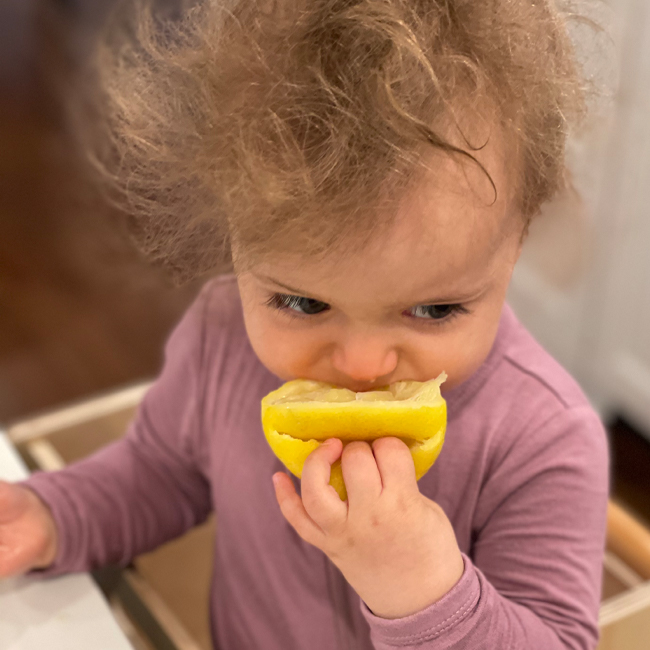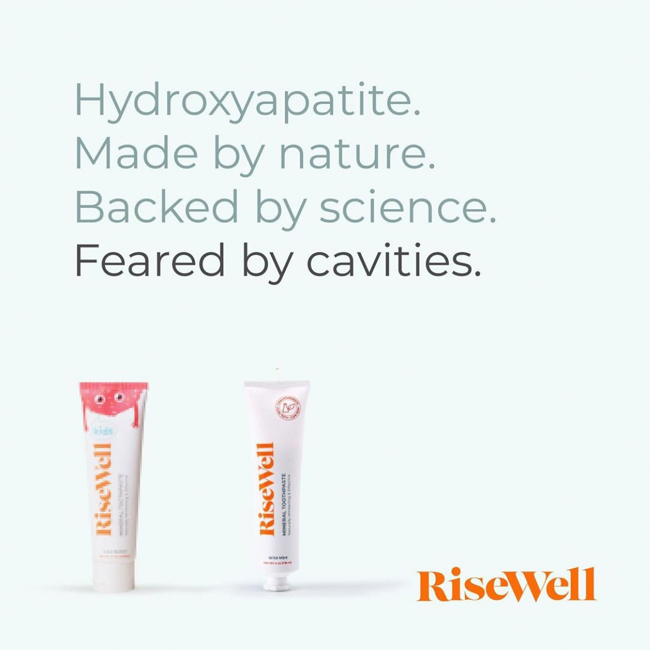I am very excited to talk about hydroxyapatite today, as I personally have made the choice to completely remove fluoride from our oral care – my daughter and I are fully hydroxyapatite converted, and today we are going to learn a bit about it’s magic powers!

Hi Ashley!! Thank you for constantly bringing your expertise to the table. I’m always excited to talk to you and learn from you. With today’s topic, I’m really looking forward to learning more, as I’m coming from the standpoint of someone who tries to live life quite “naturally.” Many years ago, I started looking into “natural” toothpastes, and that just grew tenfold once Collins got to the age where she would be needing to use toothpaste. Actually, let’s start with that…people can read your interview about all things kids and teeth here, but when should kids start brushing their teeth and using toothpaste?
Hi Lauren! Thanks so much for having me… again! That’s a great question and one that I get often. You should start brushing your child’s teeth as soon as they have one tooth to brush! I actually recommend introducing a toothbrush before they get their first tooth. This helps them get used to the feeling of toothbrushing! You can use a rice-size amount of toothpaste for children under age 3, and a pea-size amount of toothpaste for those ages 3 and up!
As a dentist, I know you see the benefits of fluoride, and I’m sure you also see people like me, who would rather skip the fluoride. Can you tell us why fluoride is used?
Fluoride is a natural occurring element that has a positive effect on oral health, because it makes teeth more resistant to cavities! When fluoride is present on the teeth, it pairs with your saliva’s calcium and phosphate to form fluorapatite. Fluorapatite is strong and very resistant to cavities. In other words, fluoride can prevent, and even reverse, cavities that have started! Fluoride is a safe, effective, accessible, and economical way for all families to limit tooth decay.
Are you comfortable talking about some of the cons of fluoride?
Many people ask me if fluoride is toxic. It is toxic, in massive quantities, as is many common substances that we need are (ie. salt, iron, oxygen, even water). Therefore, I do not consider that a con, because an adult man would have to drink 1900 8oz glasses of water in one sitting to reach acute-fluoride toxicity!
But, there is a con of fluoride: If higher than optimal amounts of fluoride are ingested in early childhood, it can cause dental fluorosis. Dental fluorosis can cause small white specks on the teeth. In its mildest form, dental fluorosis does not change the function of the tooth and often goes unnoticed by the child and caregiver. Water fluoridation has an optimal fluoride level to provide people with cavity prevention without causing dental fluorosis. This means that dental fluorosis is often caused from swallowing too much toothpaste as a child. To decrease the risk of dental fluorosis, we recommend you spit out your toothpaste rather than swallow it! With the exception of dental fluorosis, scientific studies have not found any credible links between fluoride use (toothpaste, water fluoridation) and any adverse health effects.
Okay, now here’s the reason I asked to do this additional interview. In my research for natural toothpastes, I came across this thing called “hydroxyapatite” and it really intrigued me. Collins and I are now both using toothpastes that have hydroxyapatite in them, and therefore are fluoride-free, since that will still be the route we choose to go. Can you tell us what hydroxyapatite is?
Hydroxyapatite (high-drox-ee-ah-pah-tight) is a biocompatible material found in our teeth, bones, and saliva! It makes up 96% of our tooth enamel (the hard, outside layer) and 70% of our tooth dentin (the middle layer). Because it is the main component of enamel and dentin, hydroxyapatite binds to teeth and strengthens them, making them more resistant to cavities. It can also re-mineralize tooth decay that has started, has natural whitening properties, and can limit tooth sensitivity. So, compared to fluoride, which changes tooth composition and creates fluoroapatite as a shield, hydroxyapatite feeds teeth exactly what they are made of to help re-mineralize teeth and protect teeth against cavities.
If I wasn’t sold on hydroxyapatite already…I’m sold now! What are the pros and cons you are seeing from hydroxyapatite?
Studies are finding that toothpastes containing hydroxyapatite are just as effective at preventing and re-mineralizing tooth decay as fluoridated toothpastes. What is also incredible, is that hydroxyapatite toothpaste has no risk for causing dental fluorosis. A limitation to children’s fluoridated toothpaste is that we have to monitor the amount of fluoride added into toothpaste, so as to not cause dental fluorosis. Since fluoride’s effectiveness is dose-dependent, this can be an issue. But with hydroxyapatite toothpastes, this is not a problem. The use of hydroxyapatite in toothpaste doesn’t require different dosages for infants, children and adults – it is all already at its optimal level with no risk. Also, for fluoride to be effective, it requires the calcium and phosphate ions in your saliva as I mentioned previously. People with dry mouth (xerostomia), may not be getting the benefits of fluoridated toothpaste, and could benefit from a hydroxyapatite toothpaste.
The cons of hydroxyapatite toothpaste is that they are expensive and not as accessible for people as fluoridated toothpastes are. Also, hydroxyapatite toothpastes will not contain the American Dental Association or Canadian Dental Association seal of effectiveness, as fluoride is still considered the gold standard for oral care in Canada.
I hope one day it is more accessible, and recognized in Canada. I was amazed to see that Japan has been using hydroxyapatite as their standard of care for over 40 years!

Now, this is not related to hydroxyapatite, but I drink lemon water every morning, and I was always following the rule that I should wait at least 20 minutes before brushing, to protect my enamel. After talking to you, I think that might not be quite long enough. Can you talk about that, please?
Yes! Wait 30-60 minutes after eating or drinking before brushing your teeth. The reason for this is because after you eat or drink, your enamel is weakened from the food/drink acids. If you brush while your enamel is in a weakened state, it can wear down your enamel! Drink water after you eat to help clean your teeth and let saliva get your mouth’s pH back to normal. Now, that being said – if you have to leave the house and you haven’t brushed your teeth yet for the day, because you are waiting for the 60-minute mark – please brush your teeth! Just try to wait 30-60 minutes most of the time. Or, consider brushing your teeth before you eat.
Are there other foods and drinks that people consume, where they should have a waiting period before brushing?
If you have anything really acidic, such as oranges, grapefruit, lemons/lemon water, blueberries, tomatoes/tomato-based items, soda, carbonated water, sport drinks, etc., try to wait 60 minutes before brushing. With any other food or drink, I recommend waiting 30 minutes before brushing.
People should follow your Tooth Tip Tuesday, as you’re continuously sharing wonderful information about kids and teeth, but what would be your top 1-3 tips for adults to help kids start brushing, while making it a fun process? For me, I know Collins seeing me brush my teeth, makes her want to do the same!
Thank you so much! I love sharing my weekly tips to help other caregivers feel confident and knowledgeable in caring for their child(ren)’s teeth. My top 3 brushing tips would be:
- Start early. I mentioned this before, but introducing a toothbrush to your child between 3-4 months helps desensitize the mouth and get them used to brushing!
- Make toothbrushing fun! Let them pick between two toothbrushes, read books about brushing, watch videos about brushing, let them brush a doll’s teeth and then you brush their teeth, etc. Maybe you play a fun, silly song every time you brush! Try new things to keep it fun and use positive reinforcement.
- Lay your child down while you brush for them! This naturally relaxes their mouth muscles and is easier for you to see and make sure all the teeth are clean.
Is there anything else you want to add?
Not all families have the money or resources to choose to be fluoride-free. So for now, fluoride is still the gold standard. But the current studies and success of hydroxyapatite toothpaste have me excited to see where it goes in terms of the future of toothpaste and dentistry in general!
Thank you, Ashley! Always so grateful for your time!
Ashley was wonderful to point out that hydroxyapatite toothpastes are not accessible for so many, because of the price point. I hope one day that changes!! If it is accessible for you, and you’re considering it, I am an affiliate for Risewell, and you can use coupon code LAURENEB10 for 10% off.
Happy Brushing!


